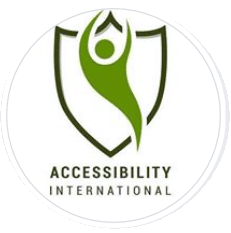It’s that time of year! Students are heading back to school with their shiny new back-to-school tools. Many will still be learning remotely, or be participating in a hybrid program where they are learning at home some of the week. For most, this means choosing a school, signing up for classes, meeting new instructors, learning how to obtain and submit assignments, figuring out online classes, and hopefully a lot of learning.
That back to school to-do list is challenging, for students and their parents. Researching curriculums, communicating with instructors, and interacting with online learning systems, and taking tests are not so easy.
People with disabilities make up as much as 25% of the US population, and up to 22% in Canada. For some, the biggest issue is physical access – the need for ramps, elevators, and automatic doors. For others, accessibility barriers to electronic information needed to participate in education are the largest obstacles.
Educational Websites
Every educational institute has a website now. It shows where the school is located, how to contact staff members, course outlines, and many other resources.
It’s vital that these websites be accessible for people using assistive technology. Web pages need to be screen reader–friendly. Videos require captions, transcripts, and audio descriptions. Digital documents found within the websites need to be formatted correctly so people using assistive technology can navigate, understand, and use the information on a variety of browsers and with a variety of tools. Accessibility features also improve the behavior of websites using mobile access as well.
“Some websites aren’t accessible with screen readers, which are software programs on computers that make them usable for people who are blind. I’m not a technology person, so I have no idea why they don’t work, they just don’t. My computer just doesn’t read the appropriate content for some websites.” Comments of Gabriella Drago, a blind student.
And it’s not just the students – many parents have disabilities and need access to information found on school websites as well.
Textbooks and Course Materials
The most important tools for students are their course textbooks and materials. These should be available in a digital format that can be used by people with disabilities using assistive technology. With so much remote learning going on, accessibility of classroom materials is more important than ever.
Accessible digital documents are helpful for people with mobility issues who cannot carry large quantities of actual textbooks. They are user-friendly for people with dyslexia who may prefer to have their course material read aloud. And they are essential for people who are blind or have low vision. Not only should these materials be available in digital format, but they must be correctly formatted with headings so students can navigate the material quickly and easily to find what they are meant to be learning, active links, accurately described text alternatives for images, and clearly identified lists and tables that can be understood by a person who cannot see these elements.
Gabriella Drago comments about her school materials: “Maybe there’s a great solution for this problem that I just haven’t found yet, but my college textbooks are all Microsoft word files. Can you imagine reading a book as a word document? It sucks! I can’t skim through pages or even find page numbers. I sometimes hit buttons and completely lose my place in the book. A table of contents is useless. It is not fun. I’d much rather a simpler way to read books…”
“Sometimes I feel angry and frustrated,” says Sheleesha Taylor, [another blind student]. “My classmates can say, ‘I did my homework in three hours,’ and I think, ‘Lucky you. I had to obtain this document and find it in a usable format and struggle harder because of the added time.’”
Arizona State University’s Alternative Formats Lab talked about the process of producing accessible materials. “Some textbooks take only a few days to be “translated,” but others can take weeks. Some are completed all at once; others are produced in chunks. Either way, the lab’s staff is constantly working under pressure to keep up.
“Some publishers provide books in a digital format, usually a PDF, which still is inaccessible to a visually impaired person. Those files have to be converted.”
Pictures, videos, graphs and tables
“If there are photographs, figures, or tables, those must also be converted. Some are made into tactile form; others are verbally described by the staffers.”
“If you think of a flowchart, visually, it’s complicated. One student staffer came up with a way to demonstrate it linearly,” Chad Price, director of ASU’s Disability Resource Center, said. “They’re being innovative in their own way.”
“Math and science texts are particularly challenging, and many of the student workers are engineering grad students, who not only grasp the complicated concepts but also can think of new ways to translate the information.”
Jessica Newton, who reviews all of the materials the staff converts, said that a student recently graduated with a degree in molecular biology and had her textbooks converted to Braille. “I thought I was going to lose my mind,” she said. “When Braille was created, even when math Braille was created in 1972, nobody anticipated the advances in sciences like DNA. We almost had to create her books from scratch.”
“Newton helped to develop the process for doing tactile diagrams, which weren’t even provided when she was a student. One way to do it is to print complicated graphics onto heat-encapsulated paper, which is then run through a machine dubbed “the toaster,” which heats the paper and raises the ink so the image can be felt. Images also can be embossed.”
Learning Management Systems
As we move deeper into the age of technology, and with remote learning so prevalent these days, educational tools are moving with us. More and more educational institutions are using learning management systems to provide information and track participation, homework, and test scores. Many are also used to communicate between students and teachers.
These new systems need to be accessible, but also the content uploaded should be clearly labeled and easy to navigate. Alternative content formats like PDFs need to be created in ways that allow them to be read by users of assistive technology. Scanned handwritten notes and documents cannot be understood by a screen reader or Braille display.
“Even if a school uses a learning management system that is completely accessible to students with vision, hearing, or other impairments, the odds are that at some point some students will hit a snag, says L Scott. Lissner of the Association on Higher Education And Disability, who also works at Ohio State University. “We still have 5,000 faculty posting content and [an accessible learning management system] doesn’t stop them from posting something inaccessible,” he says. “It doesn’t screen their content. It provides an accessible building but you might not be able to get into every room.”
Disabled students who can’t access their course materials can fall behind fast, so experts suggest they make an effort to articulate their needs to instructors before class even starts.
Accessible Tests
Testing systems also need to be understandable and navigable. Barbara Henderson, leader of the Tests and Assessments program at American Printing House for the Blind, says, “I don’t consider a test to be truly accessible unless the test taker can take the test independently or with a modicum of independence. To ensure that a computer-based test is accessible for persons who are visually impaired, I suggest that it be designed for the medium from the ground up. Retrofitting paper-and-pencil tests for computer presentation is often unsuccessful. Test designers should write specific CBT [computer-based testing] items, the presentation of which will be enhanced or, at least, supported by the computer format. It is possible to do so if test developers follow general accessibility features, including making their software amenable to special technology… Other important considerations are adequate training for the test administrators as well as for the test takers. No new or special circumstances should be introduced to anyone on the day of the test!”
Ready to Learn, Ready To Teach
With the right tools, instructors can reach all their students, and every student has the opportunity to learn the material presented to them this coming school year. Are your materials accessible? Will you reach every student?



